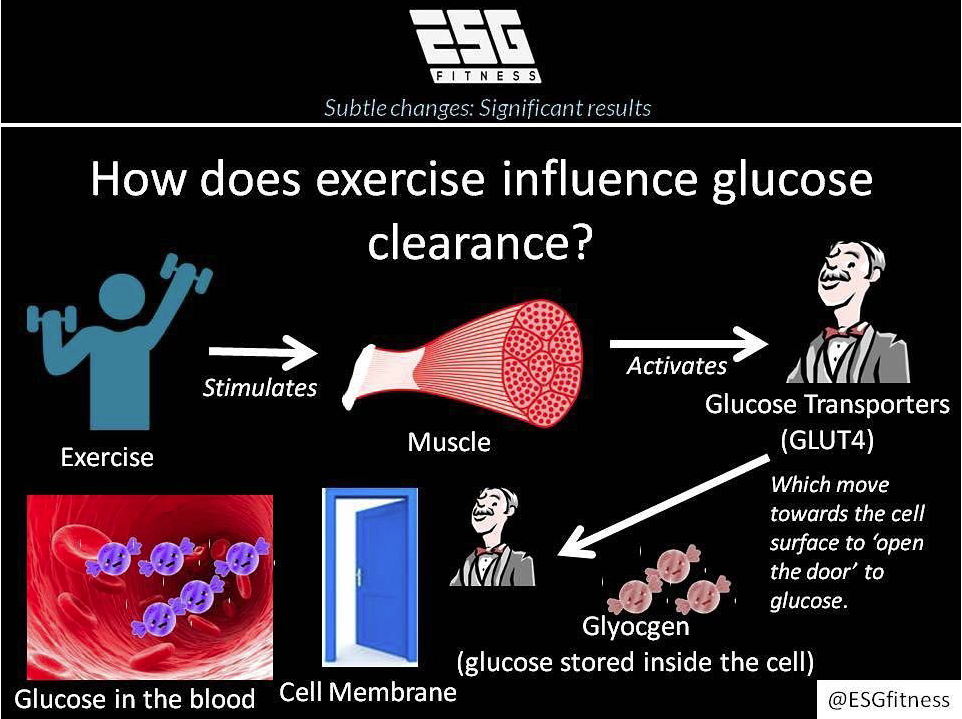Health benefits
Regular physical activity has been associated with numerous health benefits including improved control of blood glucose and management of type 2 diabetes; reduced risk of type 2 diabetes, heart disease, and premature death; lower blood pressure and fat levels; and reduced rates of some forms of cancer, depression and osteoporosis. The benefits of regular physical activity are numerous which can be gained regardless of whether you lose weight or not.
Biological changes

The reasons why regular exercise is an effective way to improve blood glucose control and type 2 diabetes management and reduces the risk of type 2 diabetes is because exercise increases the activity of receptors within the muscle that are responsible for transporting glucose uptake from the blood into the muscles that will help to reduce blood glucose levels. Exercise also helps to build and maintain muscle mass that increases the capacity for blood glucose uptake.
Australia’s national physical activity guidelines recommended being active on most, preferably all days of the week and to accumulate at least 150 minutes of moderate-vigorous physical activity each week . Bicycling that uses large muscle groups is a great form of exercise to achieve this. Walking, jogging/running and swimming are other great options.
It is also recommended to do muscle strengthening activities – also known as resistance exercise or weight training, on at least 2 days per week. This type of exercise typically involves overloading the muscles with some type of resistance such as body weight exercises, circuit training, pilates, lifting weights or using stretch bands.
Type of exercise
Research shows that the most effective way to improve insulin sensitivity and improve blood glucose control that will help to reduce risk of type 2 diabetes is by combining moderate-vigorous aerobic exercise and resistance exercise throughout the week.
In addition to participating in sufficient regular physical activity, research shows that independent of the overall amount of physical activity you do, the amount of time spent sitting and sedentary behavior is an independent risk factor for the risk of type 2 diabetes. This is because muscle cells are constantly sensing and responding to their environment, and the muscle contractions that occur each time we move induces signals in the muscles that stimulate glucose uptake. Thus, the amount of muscle contractions and inactivity over the whole day counts. It is great to break up long periods of sitting as often as possible.
Kindly contributed by “Professor Grant Brinkworth, PhD, MBA
Principal Research Scientist in Clinical Nutrition and Exercise Science CSIRO
Health & Biosecurity
Effects of sitting
Professor Neville Owen, Head of the Behavioural Epidemiology laboratory at the Baker Heart & Diabetes Institute in Melbourne strongly endorses bicycle use for good physical health, for recreation and for everyday transportation. Riding a bike is not only good for our health, but also good for the planet.
Every time we get on the bicycle, we accrue more health-enhancing aerobic physical activity. And, if we ride up hills and get off the saddle. we also get some very good resistance activity. And, spending less time in cars burning fossil fuels is good for planetary health. It also means that we spend less time sitting.
Research at the Baker Institute has shown that prolonged periods of time spent sitting can have adverse affects on our metabolic health, increasing our risk of diabetes and heart disease.
Contributed by Professor Neville Owen
Head, Behavioural Epidemiology Laboratory
Baker Heart and Diabetes Institute
National Physical Activity Guidelines
Children and Young people (5-17 years)
- Accumulating 60 minutes or more of moderate to vigorous physical activity per day involving mainly aerobic activities.
- Several hours of a variety of light physical activities;
- Activities that are vigorous, as well as those that strengthen muscle and bone should be incorporated at least 3 days per week.
- To achieve greater health benefits, replace sedentary time with additional moderate to vigorous physical activity, while preserving sufficient sleep.
Adults (18-64 years)
- Doing any physical activity is better than doing none. If you currently do no physical activity, start by doing some, and gradually build up to the recommended amount.
- Be active on most, preferably all, days every week.
- Accumulate 150 to 300 minutes (2 ½ to 5 hours) of moderate intensity physical activity or 75 to 150 minutes (1 ¼ to 2 ½ hours) of vigorous intensity physical activity, or an equivalent combination of both moderate and vigorous activities, each week.
- Do muscle strengthening activities on at least 2 days each week.
The current situation of people meeting national Guidelines - 2017/2018
National Health Survey: First Results, 2017-18 of people undertaking 150 minutes or more of exercise
